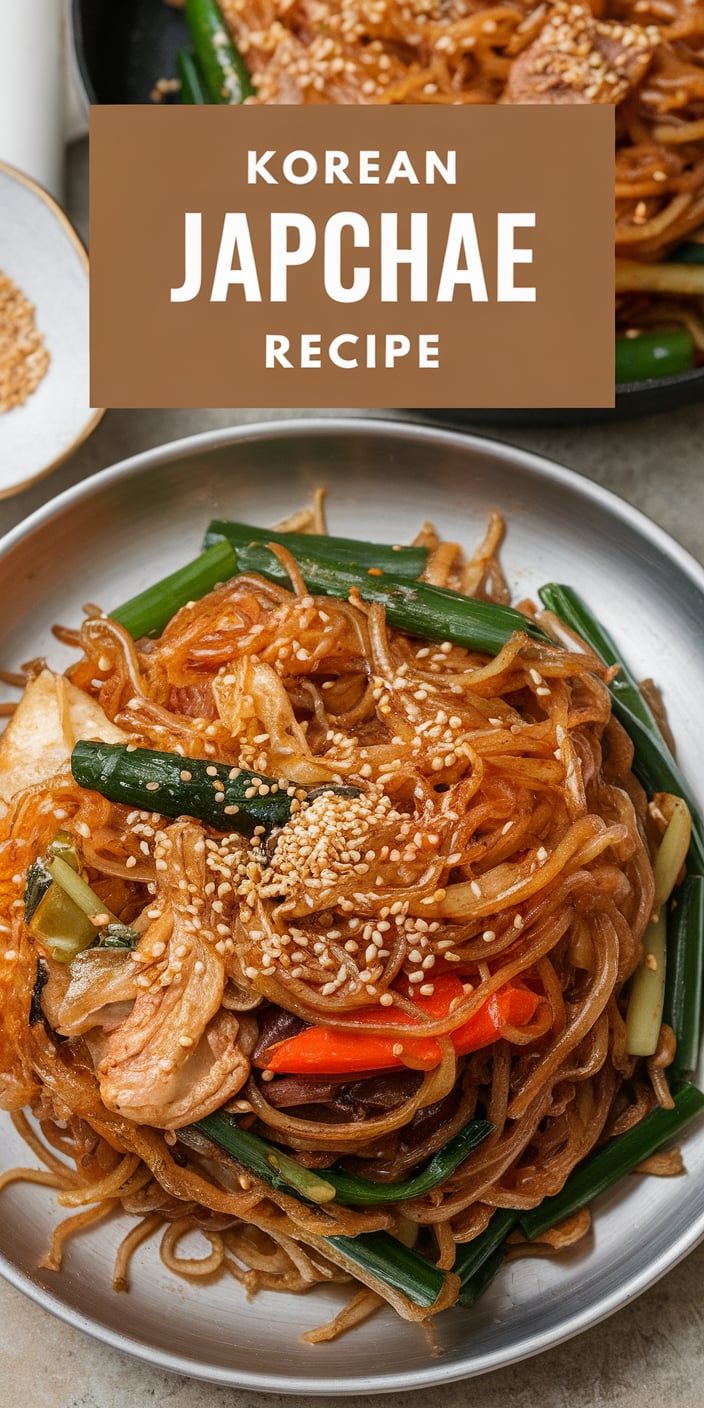Welcome to the ultimate guide for creating an authentic Korean Japchae, a vibrant glass noodle stir-fry that has captured the hearts of food lovers worldwide. This delectable Korean recipe transforms simple ingredients into a culinary masterpiece that balances flavors, textures, and nutrition in every bite.
Korean Japchae isn’t just a dish—it’s a celebration of Korean cuisine. Made with sweet potato glass noodles and an array of colorful vegetables, this versatile recipe can shine as a side dish or stand alone as a delightful main course. Whether you’re a seasoned cook or a kitchen novice, mastering this authentic Korean recipe is easier than you might think.
Key Takeaways
- Japchae is a traditional Korean glass noodle stir-fry packed with flavor
- Sweet potato noodles create a unique texture and taste
- Can be prepared as a side dish or main course
- Offers a balanced mix of vegetables and protein
- Represents an authentic piece of Korean culinary culture

Introduction to Traditional Korean Japchae
Japchae represents a culinary treasure in Korean cuisine, weaving together rich flavors and centuries of cultural tradition. This beloved dish transforms simple ingredients into an extraordinary culinary experience that has captivated food lovers worldwide.
Korean cuisine history reveals that Japchae originated during the Joseon Dynasty, initially created as a royal delicacy. The traditional Japchae emerged as a symbolic dish served during special celebrations and important gatherings.
Cultural Roots and Significance
The story of Japchae begins with a fascinating historical narrative. Originally introduced at a royal court banquet, this dish quickly became a symbol of Korean culinary artistry. Its popularity spread beyond palace walls, becoming a cherished recipe in households across Korea.
- Originated in the early 17th century
- First prepared for Korean royal court
- Symbolizes hospitality and celebration
What Makes Japchae Exceptional
Traditional Japchae stands out due to its unique combination of textures and flavors. The dish combines sweet potato glass noodles with a vibrant mix of vegetables, creating a harmonious blend that delights the palate.
| Ingredient | Nutritional Benefit |
|---|---|
| Sweet Potato Noodles | Low-calorie, gluten-free carbohydrate |
| Spinach | Rich in iron and vitamins |
| Carrots | High in beta-carotene |
Essential Cooking Utensils for Japchae
Preparing authentic Japchae requires specific cooking utensils that help maintain traditional preparation methods. The right tools can significantly enhance the cooking experience and final dish quality.
- Large non-stick wok
- Sharp chef’s knife
- Cutting board
- Long cooking chopsticks
- Mixing bowls
“Japchae is more than a dish; it’s a celebration of Korean culinary heritage.” – Korean Cuisine Expert
Understanding the Japchae ingredients and cooking techniques transforms this recipe from a simple meal to a culinary art form deeply rooted in Korean cultural traditions.
Korean Japchae Recipe: Step-by-Step Instructions
Mastering the Japchae recipe is easier than you might think. This classic Korean dish combines delicious flavors and textures that will impress your family and friends. Let’s dive into how to make Japchae with these detailed cooking instructions.
Ingredients You’ll Need
- Sweet potato glass noodles (dangmyeon)
- Beef or tofu (optional)
- Fresh spinach
- Carrots
- Shiitake mushrooms
- Green onions
Japchae Cooking Ingredients
| Ingredient | Quantity | Purpose |
|---|---|---|
| Soy sauce | 3 tablespoons | Primary seasoning |
| Sesame oil | 2 tablespoons | Flavor enhancement |
| Sugar | 1 tablespoon | Balance flavor |
| Minced garlic | 2 cloves | Aromatic base |
Cooking Steps
- Boil sweet potato noodles for 6-8 minutes until soft
- Drain and rinse noodles with cold water
- Stir-fry vegetables separately
- Cook meat or tofu
- Combine all ingredients in a large pan
- Season with sauce mixture
When preparing your Japchae recipe, timing is crucial. Stir-fry ingredients quickly to maintain their vibrant colors and crisp textures. The key to authentic Japchae cooking instructions is keeping each ingredient distinct while creating a harmonious blend of flavors.
Pro tip: Let the noodles cool slightly before mixing to prevent them from becoming mushy. Your homemade Japchae will taste just like a traditional Korean restaurant dish!
Conclusion
Creating authentic Korean Japchae is more than just cooking a meal—it’s exploring a rich culinary tradition. With the recipe and techniques you’ve learned, you’re now equipped to craft this delightful dish that brings the vibrant flavors of Korean cuisine right into your kitchen.
When considering Japchae serving suggestions, remember that this versatile dish pairs beautifully with traditional Korean food pairings like kimchi, steamed rice, and grilled meats. Experiment with different protein options or keep it vegetarian to suit your taste preferences.
For optimal enjoyment, follow these Japchae storage tips: refrigerate any leftovers in an airtight container for up to three days. When reheating, use a skillet to restore the noodles’ perfect texture and prevent them from becoming soggy. The flavors often develop even more depth after a day of resting in the refrigerator.
Your culinary journey doesn’t stop here. Korean cuisine offers a world of exciting flavors and techniques waiting to be discovered. Keep exploring, stay curious, and most importantly, enjoy the delicious process of creating meals that connect you to a rich cultural heritage.
